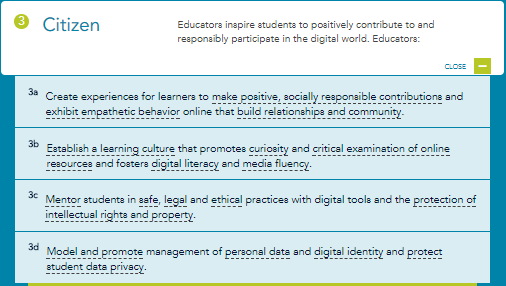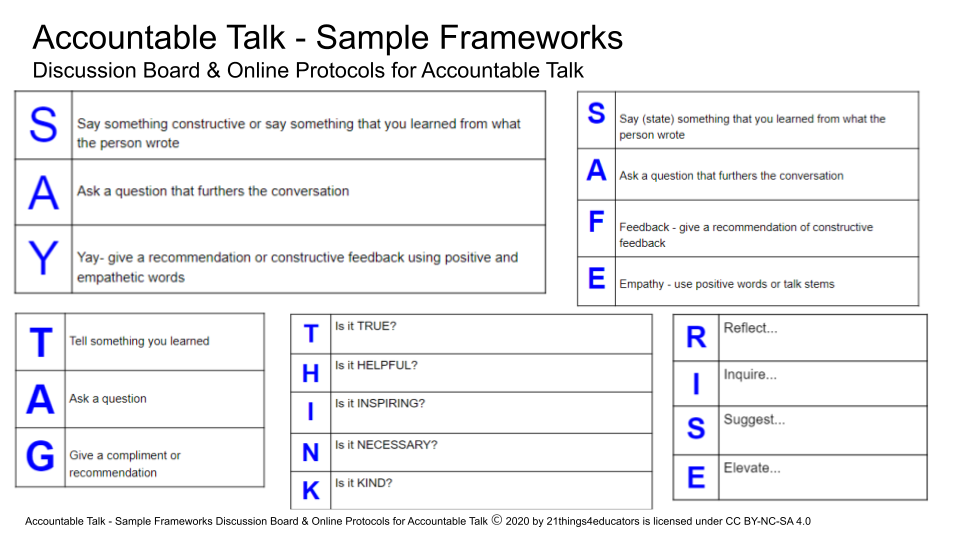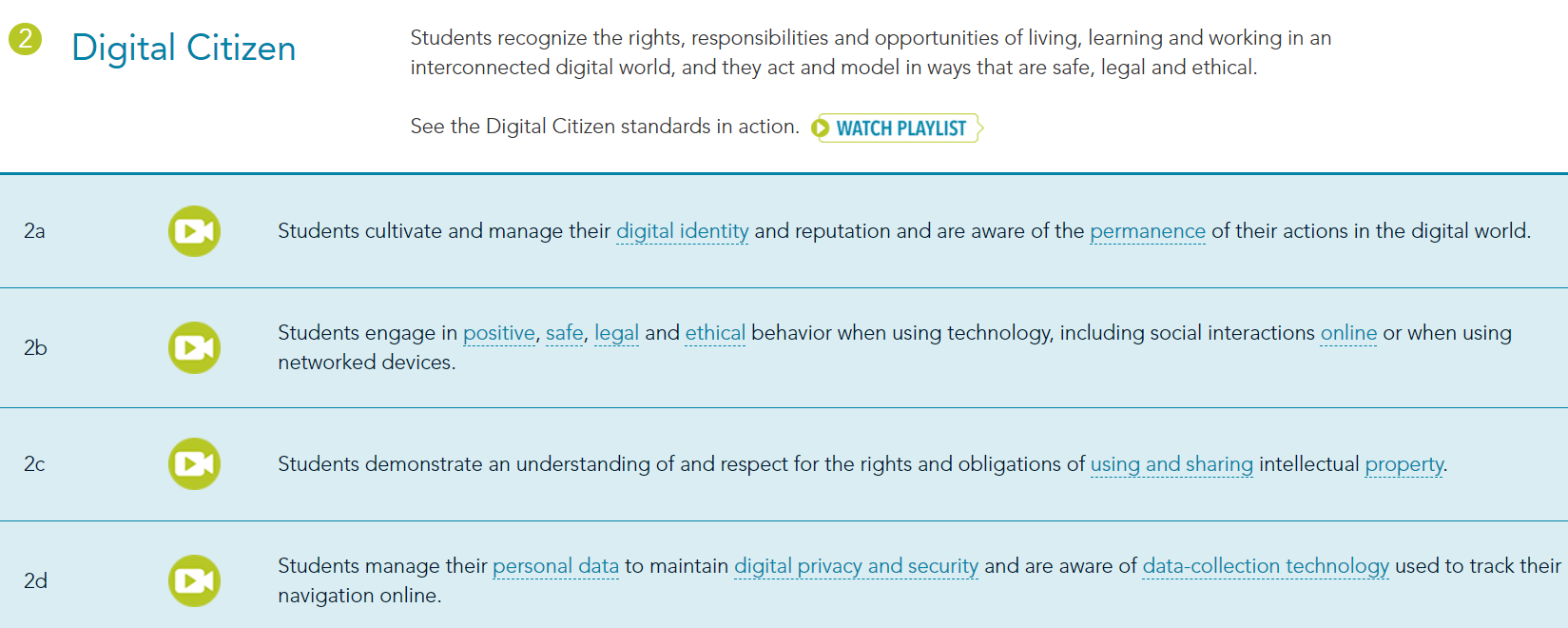Begin the "Define" section by reflecting on what you know and want to know about this "Thing."
Digital Citizenship is a concept which helps teachers, technology leaders, and parents talk about what all users should know regarding appropriate technology use. Digital Citizenship is more than just a teaching tool; it is a way to prepare students/technology users for a society full of technology. In this “Thing” we will introduce you to Citizenship and how it has transformed in an era of online learning from the 9 Themes of Digital Citizenship (where we educate, respect, and protect online) to an emphasis on the student role as digital agent, digital interactor, and digital self. We will also focus on teaching students to interact appropriately online in a socially responsible and empathetic manner using positive and accountable talk stems. (ISTE Educator - Citizen 3a).
Other aspects of Digital Citizenship will be addressed in other "Things". In “Search Strategies”, you will understand how to provide frameworks for students to critically evaluate online resources such as the CRAP(P) test or CARRDSS system. (ISTE Educator - Citizen 3b) In “Be Legal & Be Fair” you will explore respect for intellectual property, fair use, and copyright. (ISTE Educator - Citizen 3c). Finally, in “Data Privacy” you will complete your tour of the ISTE Citizen Standard by exploring the importance of protecting student privacy and helping them to understand the creation and impact of their digital footprint. (ISTE Educator - Citizen 3d)
Learning Objectives
Click on each title below to see detailed information.
ISTE Standards
Let’s begin our journey with an exploration on the ISTE Standards that guide this work. Start by exploring the Educator Standard #3 - Citizen. Next, review the Student Standard #2 - Digital Citizenship. As you move through, consider using a VENN Diagram to plot the similarities, differences, and intersections.
ISTE Standards for Educators: 3-Citizen
At this time, please go to the ISTE Educator Standards web page by clicking on the image below and read the Citizen Standards. Clicking on the + sign will expand the window, and moving you mouse over the dotted lines will display pop-up windows with supporting details.

Select image to open the link.
ISTE Standards for Students: 2-Digital Citizen
At this time, please go to the ISTE Student Standards web page by clicking on the image below and read the Digital Citizen Standards. Clicking on the + sign will expand the window, and moving you mouse over the dotted lines will display pop-up windows with supporting details.
Please focus your attention on these standards. How will you help your students meet these ISTE Student Standards for Digital Citizen (#2)?
Select image to open the link.
Watch/Listen to these ISTE videos to gain a deeper understanding of the four components of the student standard - Digital Citizen.
2a - Digital Footprint (select image below to access the video)
2b - Online Behavior (select image below to access the video)
2c - Intellectual Property (select image below to access the video)
2d - Digital Privacy (select image below to access the video)
For the big picture, watch/listen to this ISTE video on what Digital Citizenship looks like for your students. (select image below to access the video)

Now that you have an understanding of the related ISTE standards, move on to the next section - Evolution of Digital Citizenship: Overview.
Start with the end in mind
The Evolution of Digital Citizenship is a 3 step process - from traditional to transformation to emerging roles.

Select the image to open the link.
Start your journey to understand this Evolution of Digital Citizenship by opening this document and reviewing the three columns. This overview will assist you in anticipation of the learning of each step.
Next, dive deeper into each step of the Evolution of Digital Citizenship. Start by downloading this guided notes TEMPLATE. Use it to jot down any thoughts or ideas you may have as you move through each step.

Now that you have the general picture, move on to the next section - Evolution of Digital Citizenship: Traditional.
TRADITIONAL
For many years, we have embraced the 9 Themes of Digital Citizenship as a framework for respect, education, and protections of yourself and others while online. We focused on educating students about commerce, communication, and literacy. We taught them to respect themselves and others through access, etiquette, and laws. Finally, we taught about protecting the rights & responsibilities, health & wellness, and privacy & security of yourself and others while online.
Look at the traditional 9 Themes of Digital Citizenship below. How do you teach these themes in your classroom?
Reflect in your guided notes about your thoughts and ideas on this traditional way of framing Digital Citizenship.

Now that you have an understanding of the traditional approach to digital citizenship, move on to the next section - Evolution of Digital Citizenship: Transformation.
TRANSFORMATION
With technology changing at a rapid rate, Digital Citizenship has transformed dramatically. Educators have shifted from filtering, curating, and sheltering students from potential hazards to a culture where students are empowered to review, react, and respond accordingly.
We need to shift our thinking. Consider ISTE CEO Richard Culatta’s vision shared here (select the video below to view/listen):
Let’s think about what we want our students to know, understand, and be able to do. Reflect in your guided notes about your thoughts and ideas on this transformation.
This ISTE graphic clearly identifies the components of this transformation.

Now that you have an understanding of the transformation of digital citizenship ideology, move on to the next section - Evolution of Digital Citizenship: Emerging Roles.
EMERGING ROLES
How can good citizenship transfer to good Digital Citizenship? Watch/listen to this video to find out how. (select image below to start)
In the ISTE video you learned about the three areas of New Age Digital Citizenship. Now let's dive deeper into these emerging roles: Digital Agent, Digital Self and Digital Interactor.
DIGITAL AGENT
A Digital Agent uses technology to solve problems and models compassion and kindness.
A Digital Agent:
- Advocates for equal digital rights for all
- Seeks to understand all perspectives
- Respects the digital privacy, intellectual property, and other rights of people online
Digital Agent resources document with lesson plans - make a copy
DIGITAL SELF
To cultivate the Digital Self, students must responsibly manage their digital identity and property, while respecting the privacy and rights of others.
The Digital Self:
- Is mindful of physical, emotional and mental health while using digital tools
- Leverages digital tools to collaborate with others
- Understands the permanence of the digital world and proactively manages digital identity
Digital Self resources document with lesson plans - make a copy
DIGITAL INTERACTOR
Digital Interactors communicate with empathy and authenticity. They collaborate online and vigorously vet online sources.
A Digital Interactor:
- Communicates and acts with empathy for others' humanity via digital channels
- Applies critical thinking to all online sources and doesn't share non-credible resources, including fake news or advertisements
- Leverages technology to advocate for and advance social causes
Digital Interactor resources document with lesson plans - make a copy

Now that you have an understanding of the emerging roles of digital citizenship, move on to the next section - Digging Deeper - Digital Interactor.
EMPATHY - ACCOUNTABLE TALK AND POSITIVE TALK STEMS
To encourage students to be good digital citizens, empathy and social responsibility need to be taught and supported. There are several guidelines for posting online (eg. discussion boards, blog posts, etc.) where empathy and social responsibility are embedded. In order to help your students convey empathy and social responsibility while communicating online, you might consider these frameworks.
 Five Mnemonics for Accountable Talk
Five Mnemonics for Accountable Talk
RISE
(Restate, Inquire, Say something helpful, Encourage)
SAY
(Say something constructive, Ask a question, Yay)
SAFE
(Say, Ask, Feedback, Empathize)
THINK
(True, Helpful, Inspiring, Necessary, Kind)
TAG
(Tell something you learned, Ask a Question, Give a compliment)
For an Accountable Talk Poster that you can display for your students, select the hyperlinked text.
This is the last section of "Thing" 8's Define playlist. Now would be a great time to revisit your Reflection Document and think about what you learned in this "Thing." Capture a screenshot of your results from the Knowledge Check and post them in your Reflection Document. As you move forward, consider the following: How might you use this in your own professional practice? What goals might you set for yourself, including activities, timelines, and evaluation? What connections did you make to the ISTE Standards or your own content area standards? How will you monitor your own progress towards these goals? Then proceed to the next section.
